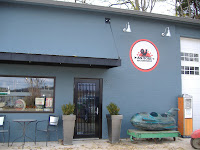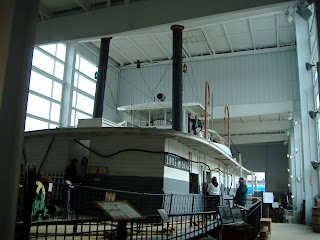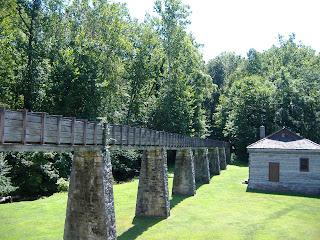This was a "bland" unit! White with beige swirls outside, all beige inside! It was sold and would be picked up in Ontario and driven to colorful Florida for the winter.
We headed east on a rainy, windy early morning with a winter advisory for the next day here in Iowa.
The wind gave us a rough ride. Clouds kept the rising sun from our eyes. Had to endure my "pet peeve"---The wind shield wiper only clears 1/2 of the passenger side window! My line of vision is divided with clear and raindrops.
Rainy days make sunny days so much more precious!
Cloudy and 56 degrees as we head through south Chicago and into Indiana.
On I-94 east to Detroit. In the distance steam is rising from smokestacks on the factories along the lake.
A call to our broker at the border confirms that paperwork is at the border. That makes for a quick smooth crossing.
Still some leaves with color. Enough color to accent the bare branches and green pines
Into Michigan, searching for a safe place to park this "elephant" for the night. Thankful that we have driven out of the rain. A Super Walmart in Battle Creek. A long walk around the store and the parking lot. A great steak burger at Steak & Shake. A clean diner with friendly servers who really seem to enjoy working together. A good night's sleep.
The rain stops as we near Detroit in the morning. Followed the signs to the Ambassador Bridge into Windsor Ontario. Major construction on the bridge. Signs say "follow signs do not follow your GPS!"
Readjust for Canada:
- km instead of miles.
- signs are both French and English.
- gas sold in liters instead of gallons (price was about $4.50/gal).
- highway numbers are printed on a crown. Roads and towns have very definite English sounding names: Thames, London, Queen's Road, etc.
Acres of flat farmland interspersed with farmsteads.
Some fields have been harvested and tilled, some still have standing corn and soybeans waiting for the combine. Combines were running in the rain.
Large windmills with blades turning are scattered across the horizon in all direction for many miles.
This area of Ontario is like an island between Lake Erie on the South and Lake Heron on the North. A short drive either direction and you will be on the coast.
Past the exit to Leamington, the tomato capitol of Canada. Another season we would be driving past acres of tomato plants.
Acres of solar panels beside the industrial section of Tilby.
Trucks, trucks, trucks carrying "stuff" both directions. Lots of containers & new cars.
Yeah! Some blue sky ahead!
Nice service centers/rest stops. Each has a sign a couple miles before the exit that states in French & English: Fatigue Kills Take a Break
Arrived at the dealer in the rain, unhooked & unloaded in the rain, quick check-in, and heading back west in a downpour all the way back to Windsor.
Yeah! blue skies can be seen ahead!
Back through the construction obstacle course of orange pylons, through customs, over the Ambassador bridge, pay toll and head into Detroit traffic.
We heard that the Republican Presidential Candidates were in the area for a debate that evening, but did not see them nor any of the "occupiers."
Very strong winds that howled around the corner of our motel in Jackson, Michigan all night.
Scraped ice from windshield the next morning before continuing west through Chicago and into Iowa with cold wind and partly cloudy sky, but thankfully no rain!
LeClaire, Iowa
A quick lunch
 at McDonalds overlooking the Mississippi River, a short drive to uptown and a stop at the "American Pickers" shop. Disappointment! They were closed for filming, but we could take a picture and perhaps stop another time when we were in the area. You can check them out at their website www.antiquearchaeology.com. or watch on History Channel on Monday nights.
at McDonalds overlooking the Mississippi River, a short drive to uptown and a stop at the "American Pickers" shop. Disappointment! They were closed for filming, but we could take a picture and perhaps stop another time when we were in the area. You can check them out at their website www.antiquearchaeology.com. or watch on History Channel on Monday nights.Along the bank of the river is the Buffalo Bill Museum and the River Pilots' Pier with the Lone Star Steamer to tour.
William F. "Buffalo Bill" Cody's life of legend started in 1846, the year he was born near LeClaire. Cowboy, Pony Express Rider, Scout, Marksman and International Star of his Wild West Show. A short video gives an overview of his early life. It was interesting to learn that he used glass balls and "birdshot" for his shooting exhibitions at the shows. Only a small section of the museum displays memorabilia from his life. Most of the exhibits show items used by the people living in the area over the past hundreds of years including the Sauk and Fox Indian tribes.
Interesting items we found:
- LeClaire Manufacturing Company made a conversion kit to convert a push reel lawn mower to power mower with a Clinton engine.

- A picture of a tug boat pushing a raft of clams to be made into pearl buttons at the local button factory. Tools used to make them.
- Because of the absence of soft wood for lumber many buildings were built with limestone from several local quarries. Most all early construction used limestone for foundations. 50 and 60 pound hammers used!
- A John Deere wrench and a Ford wrench that were included with early purchases of vehicles and tractors for repair and maintenance.
- A charcoal burning iron and a gasoline burning iron from the 1900's. Can't im
 agine pressing clothes with these!
agine pressing clothes with these! - An 1873 American treadle sewing machine. A whole section of vintage clothes, quilts and handiwork with stitches that I have never seen before.
- A baby cradle on wheels with a hook that was attached to a farm implement when mother went to field to work.
- The family of James J. Ryan II, a 1920 graduate of LeClaire High School, donated his office to the museum. He attended Iowa State University and taught at the University of Minnesota. His nickname, "Crash Ryan", was earned because of he tested automobile safety equipment including a hydraulic bumper and seat belt designs. A Flight Data Recorder (Black Box) which he invented is on display.
- A display featuring James B. Eads, a self taught engineer who listed LeClaire as one his hometowns. He is known as the man who mastered the Mississippi River because of the "jetty system" he introduced. Because he was in salvage, raising sunken boats, he learned how to navigate the rapids of the Mississippi. His gunboat designs during the Civil War were a precursor to the modern submarine. He is known for the Eads Bridge in St. Louis. The first bridge of a significant size using steel and the largest arch bridge in the world in 1874 when it was completed.
- A cross section of the largest Rock Elm tree on record. It's height was over 50' with a crown that canopied an area measuring over 100 ft north & south by 80 ft.
 east and west! the "Green Tree" was a landmark at the beginning of the river rapids between LeClaire and Rock Island. It was a gathering place for pilots waiting for their boats to pick them up. All boats docked on the shore approximately where the Green Tree was, to change pilots and take on supplies before and after going across the rapids. It became known as the "Green Tree Hotel" when unemployed rivermen came to look for work. ( An inexpensive place to spread their blankets and cook their meals under the branches!) It died of Dutch Elm disease. It is also famous because of the formation of bark in the center. Tree experts believe it was so close to the river's edge that water washed up through the center and somehow the sun shown down through the hole, as bark needs both water and sunlight to form!
east and west! the "Green Tree" was a landmark at the beginning of the river rapids between LeClaire and Rock Island. It was a gathering place for pilots waiting for their boats to pick them up. All boats docked on the shore approximately where the Green Tree was, to change pilots and take on supplies before and after going across the rapids. It became known as the "Green Tree Hotel" when unemployed rivermen came to look for work. ( An inexpensive place to spread their blankets and cook their meals under the branches!) It died of Dutch Elm disease. It is also famous because of the formation of bark in the center. Tree experts believe it was so close to the river's edge that water washed up through the center and somehow the sun shown down through the hole, as bark needs both water and sunlight to form!
A large glass and steel enclosure, called the River Pilot's Pier, covers the only
 wood hull paddlewheel boat remaining intact that worked the Mississippi River. The "Lone Star" was built in 1869 and decommisioned in 1968. You can walk her decks as the Mississippi River flows past imagining what it was like to work the river! Climb up to see the huge pilot's wheel that steered the rudders, stand beside the paddle wheel, touch the equipment and pretend to shovel coal into the boilers. She carried and towed freight and immigrants that settled the midwest in it's early days. The last years she was used to operate a sand dredge, pumping 400 tons of sand an hour from deposits in the bottom of the river, load it into barges and take to Davenport to be used in construction, cement and other purposes. Today's tow boats navigate in a 9 ft deep channel with locks and dams but the Lone Star could operate in as little as 4 ft of water.
wood hull paddlewheel boat remaining intact that worked the Mississippi River. The "Lone Star" was built in 1869 and decommisioned in 1968. You can walk her decks as the Mississippi River flows past imagining what it was like to work the river! Climb up to see the huge pilot's wheel that steered the rudders, stand beside the paddle wheel, touch the equipment and pretend to shovel coal into the boilers. She carried and towed freight and immigrants that settled the midwest in it's early days. The last years she was used to operate a sand dredge, pumping 400 tons of sand an hour from deposits in the bottom of the river, load it into barges and take to Davenport to be used in construction, cement and other purposes. Today's tow boats navigate in a 9 ft deep channel with locks and dams but the Lone Star could operate in as little as 4 ft of water.
We see a lot of steamer trunks in antique shops, but most are just a large empty space inside. This is an original "carry-on" with wooden hangers and compartments intact!
The Mississippi River has always held a fascination for us. This museum gave us a picture of life along it's banks. But it is time to head back to our Prairie!
Thanks for traveling with us!
Prairie Schooners







